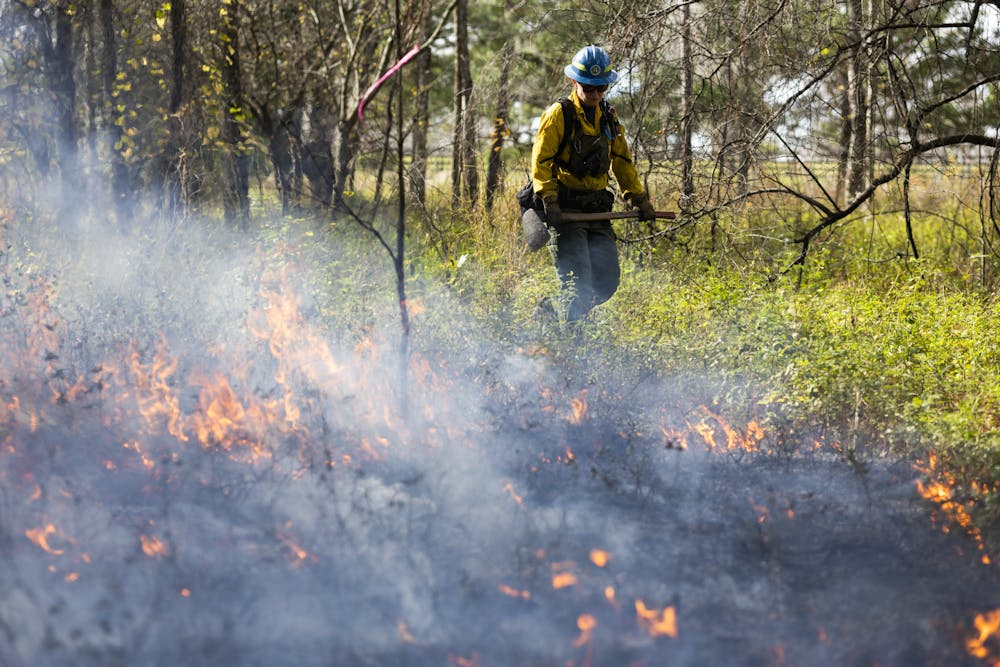With swamps and nature parks galore, Gainesville is renowned for its breathtaking landscapes. While many recognize the scenic beauty of the local environment, the practice that makes this remains commonly unexplored: prescribed fires.
A prescribed fire is the use of fire on a landscape under specific environmental conditions to accomplish land management objectives, said Tracey Sleek, a 37-year-old assistant director of the Ordway-Swisher Biological Station at UF Institute of Food and Agricultural Science.
”Fire naturally occurs in Florida landscapes because we are the lightning capital of the world due to our geography and climate,” Sleek said.
The ecosystems of Alachua, such as the wetlands and wiregrass habitats, have naturally evolved to rely on fire as a result of lightning. Prescribed fires mimic the natural rhythms of lightning from Florida summer storms that burn the landscape during the year, Sleek said. The natural communities adapted to fires depending on the seasons and the storms they receive.
While prescribed fires may seem destructive, the act of mimicking natural occurrences lowers the risk for potential wildfires, maintains species populations and helps the overall ecosystems of Florida, Sleek said.
“By applying fire tips [prescribed to] the landscape, or mimicking those natural disturbances, we are benefiting all of the different species that have evolved in Florida with fire,” Sleek said.
Local parks continue to value prescribed fires in land management, one of them being the Morningside Nature Center, at 3540 E University Ave. The Gainesville park performs cooperative burns with trained community members in-house and at Boulware Springs.
Jane Cummings, a 53-year-old nature center education supervisor for the City of Gainesville Parks, Recreation and Cultural Affairs, has been a member of the burn team since 2016. She compares prescribed fires to medical prescriptions for the land.
“If we think of environmental ecosystems as an organism, we have a baseline of what's healthy for us,” Cummings said. “Sometimes things go awry, or we're sick and we need a prescription to get us back at baseline.”
The extensive operation is done meticulously and methodically over a 12- to 16-hour day, Cummings said. Burn crew members meet at a briefing prior to the burn where they discuss the “prescription” for the fire, such as expected weather conditions, possible hazards and safety routes.
“Every time that we burn, no matter what the organization is, a very detailed prescription is written depending upon which area in the designated area you're burning and what ecosystems lay within that,” Cummings said.
Next, they develop a burn plan and burn the area in zones with two teams: the ignition team, those who light the fire, and the mock-up team.
Burn days may happen about five or six times a year depending on the size of the agency and land they manage, Cummings said.
Prescribed fires protect urban interfaces by reducing fuel loading, Cummings said. Without it, a rapid accumulation of batteries on the ground would become a fuel source dangerous to human developments.
“As you drive around our beautiful state, you see a lot of things that would catch on fire very easily,” Cummings said. “And if that did… it shuts down roads and it damages other areas.”
“The long-term effects of this process are that we, you and me and future generations, hopefully for many generations, will have open spaces to go to and listen to the trees and talk to the animals and just find that connection with the timelessness of the earth we're standing on,” Cummings said.
As she watched many prescribed burns over her eight years working at Morningside, Windy Wood, a 42-year-old nature assistant, learned the importance of prescribed fires and admired the public’s dedication to it.
“We're actually very lucky in Florida we have a lot of people who understand the importance of fire and prescribed fire, not only amongst your agencies but also amongst the public who live here,” Wood said.
The practice of prescribed fire in the area has been performed for centuries, Wood said. Native American groups such as the Timucua people and their ancestors utilized fire for land management as well as warfare and cultural practices.
Florida leads the nation in prescribed fire, said Alachua Conservation Trust’s 29-year-old fire management specialist Rachel Townsend.
The Alachua Conservation Trust, an accredited land trust, is one of multiple local organizations dedicated to land conservation. It blossomed out of the Alachua county’s slogan “Where Nature and Culture Meet.”
The organization aims to limit urban developments and preserve as much habitat as possible through conservation, land management and outreach and communications. Its efforts range from land acquisition to education initiatives with children.
“We need to protect these things that make up our history, make up our current times and hopefully make up our future,” Townsend said. “Gainesville is kind of at the heart of all of that.”
ACT works to restore altered communities through its prescribed fire program. The array of natural communities in Alachua County makes prescribed fires so important, Townsend said.
Caleb Bohrer, a 20-year-old UF anthropology freshman, recently completed a gap year with AmeriCorps NCCC, working with the United States Forest Service in the Southeast.
With wildfire response skills and knowledge in his back pocket, Bohrer appreciates the local commitment to the cause.
“Being in Gainesville with so many different state parks and other public lands around it makes me want to work with those organizations and help out where I can,” Bohrer said.
The lasting impression of prescribed fires and the local loyalty to conservation will continue to touch Gainesville for generations to come.
Contact Molly Seghi at mseghi@alligator.org. Follow her on X @molly_seghi.
Molly Seghi is a first-year journalism major at UF and a Fall 2023 Avenue Reporter. When not writing or journaling, she can be found at a live music event or working on her podcast “An Aural Account.”






